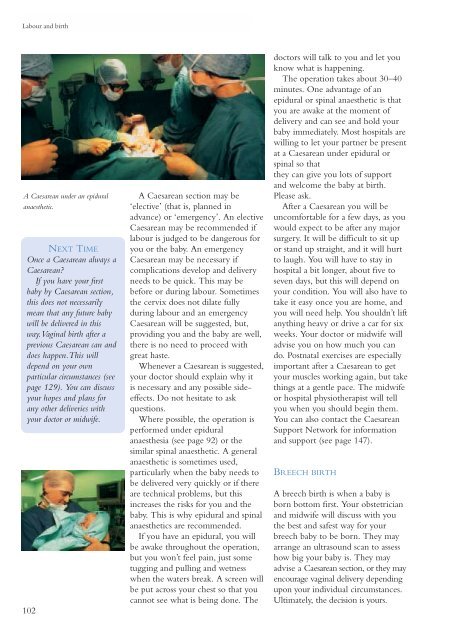here - Health Promotion Agency
here - Health Promotion Agency
here - Health Promotion Agency
You also want an ePaper? Increase the reach of your titles
YUMPU automatically turns print PDFs into web optimized ePapers that Google loves.
Labour and birth<br />
A Caesarean under an epidural<br />
anaesthetic.<br />
NEXT TIME<br />
Once a Caesarean always a<br />
Caesarean?<br />
If you have your first<br />
baby by Caesarean section,<br />
this does not necessarily<br />
mean that any future baby<br />
will be delivered in this<br />
way.Vaginal birth after a<br />
previous Caesarean can and<br />
does happen.This will<br />
depend on your own<br />
particular circumstances (see<br />
page 129). You can discuss<br />
your hopes and plans for<br />
any other deliveries with<br />
your doctor or midwife.<br />
102<br />
A Caesarean section may be<br />
‘elective’ (that is, planned in<br />
advance) or ‘emergency’. An elective<br />
Caesarean may be recommended if<br />
labour is judged to be dangerous for<br />
you or the baby. An emergency<br />
Caesarean may be necessary if<br />
complications develop and delivery<br />
needs to be quick. This may be<br />
before or during labour. Sometimes<br />
the cervix does not dilate fully<br />
during labour and an emergency<br />
Caesarean will be suggested, but,<br />
providing you and the baby are well,<br />
t<strong>here</strong> is no need to proceed with<br />
great haste.<br />
Whenever a Caesarean is suggested,<br />
your doctor should explain why it<br />
is necessary and any possible sideeffects.<br />
Do not hesitate to ask<br />
questions.<br />
W<strong>here</strong> possible, the operation is<br />
performed under epidural<br />
anaesthesia (see page 92) or the<br />
similar spinal anaesthetic. A general<br />
anaesthetic is sometimes used,<br />
particularly when the baby needs to<br />
be delivered very quickly or if t<strong>here</strong><br />
are technical problems, but this<br />
increases the risks for you and the<br />
baby. This is why epidural and spinal<br />
anaesthetics are recommended.<br />
If you have an epidural, you will<br />
be awake throughout the operation,<br />
but you won’t feel pain, just some<br />
tugging and pulling and wetness<br />
when the waters break. A screen will<br />
be put across your chest so that you<br />
cannot see what is being done. The<br />
doctors will talk to you and let you<br />
know what is happening.<br />
The operation takes about 30–40<br />
minutes. One advantage of an<br />
epidural or spinal anaesthetic is that<br />
you are awake at the moment of<br />
delivery and can see and hold your<br />
baby immediately. Most hospitals are<br />
willing to let your partner be present<br />
at a Caesarean under epidural or<br />
spinal so that<br />
they can give you lots of support<br />
and welcome the baby at birth.<br />
Please ask.<br />
After a Caesarean you will be<br />
uncomfortable for a few days, as you<br />
would expect to be after any major<br />
surgery. It will be difficult to sit up<br />
or stand up straight, and it will hurt<br />
to laugh. You will have to stay in<br />
hospital a bit longer, about five to<br />
seven days, but this will depend on<br />
your condition. You will also have to<br />
take it easy once you are home, and<br />
you will need help. You shouldn’t lift<br />
anything heavy or drive a car for six<br />
weeks. Your doctor or midwife will<br />
advise you on how much you can<br />
do. Postnatal exercises are especially<br />
important after a Caesarean to get<br />
your muscles working again, but take<br />
things at a gentle pace. The midwife<br />
or hospital physiotherapist will tell<br />
you when you should begin them.<br />
You can also contact the Caesarean<br />
Support Network for information<br />
and support (see page 147).<br />
BREECH BIRTH<br />
A breech birth is when a baby is<br />
born bottom first. Your obstetrician<br />
and midwife will discuss with you<br />
the best and safest way for your<br />
breech baby to be born. They may<br />
arrange an ultrasound scan to assess<br />
how big your baby is. They may<br />
advise a Caesarean section, or they may<br />
encourage vaginal delivery depending<br />
upon your individual circumstances.<br />
Ultimately, the decision is yours.
















